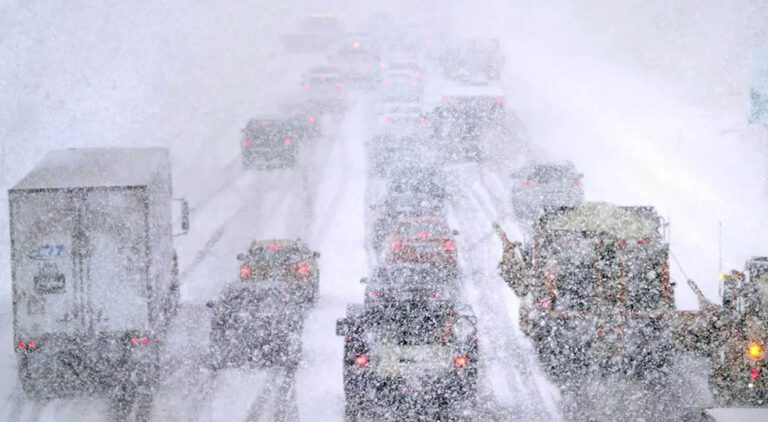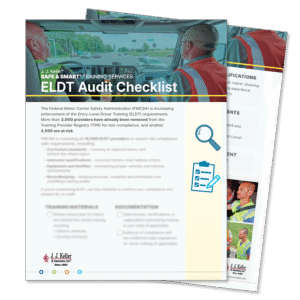LITTLE ROCK, Ark. — Winter has arrived in many parts of North America — or has it?
Actually, winter officially begins with the winter solstice.
This event doesn’t occur until 10:27 p.m. on Dec. 21.
So, even though we’re technically in the waning days of fall, professional drivers are more concerned with the weather than the actual season. Truckers know that weather conditions change, not only with the different systems that come through, but also with the time of day, the altitude and other factors.
It’s important for drivers to be prepared for winter driving conditions long before the calendar says the season has arrived.
Many drivers have worked through multiple winters on the road, and they know how to react to most situations. It may be easy for these drivers to let down their guard when driving in inclement weather — after all, they know how to handle the rig.
But complacency can be a killer. No matter how many snowstorms you’ve survived or how many times you’ve prevented a skid on an icy surface, it’s always a good idea to review and practice winter driving skills — and make sure you’re prepared for winter’s worst.
What to watch for
When temperatures drop to near freezing, rain often turns to something else. It’s pretty easy to realize that a foot of snow on the roadway presents a driving hazard. However, weather hazards aren’t always that obvious. Sometimes the rain doesn’t freeze until it hits the ground or some other object. Sometimes it looks just like water on the road surface ahead. Sometimes it IS water; other times, that wet surface could actually be a treacherous sheet of ice.
Knowing what kind of surface you’re driving on can be critical to maintaining control. Weather reports are helpful, but they can’t provide mile-by-mile information. The safest choice in any winter weather is to assume that traction is compromised. It may be easy to travel at your normal speed — but you don’t want to be in a situation where you can’t slow down.
Freezing rain can be difficult to detect, but there are signs to watch for. A key indicator is water spray coming off the wheels of a passing vehicle. If there’s no spray, the road isn’t wet — it’s frozen. Another hint comes from watching the CB or other antennas on vehicles around you. Normally, antennas are pushed backward in the windstream of a moving vehicle. A coating of ice will make them behave differently, moving from side-to-side or in a circular pattern.
Even though the main road may be clear, keep in mind that elevated surfaces may be icy. This is because the ground beneath the road surface takes longer to freeze, and it can actually warm the road enough to melt snow and sleet. However, there’s no ground underneath bridges, overpasses or elevated roadways, so any water on these surfaces can freeze quickly.
Many jurisdictions use salt or chemicals on roadways to help melt ice or prevent it from forming. How well this works depends on the substance, how much is applied and the length of time between applications. The water from melting ice dilutes the chemicals, and they become less effective as time passes. The resulting liquid can still freeze.
WINTER DRIVING SAFETY TIPS
When piloting a big rig, driving in less-than-ideal traction conditions requires slower speeds and greater following distances. Vehicle controls, such as steering and braking, should be done as gradually as possible to avoid losing traction. An occasional check of the brakes, while moving at a slower speed, is often advisable.
Make sure your vision is unobstructed.
Also, keep in mind that slippery roads aren’t the only hazard presented by winter weather. Sun glare is severest during the winter because white snow reflects most of the sunlight that hits it. Sunglasses are an important accessory for improving vision and reducing eye fatigue. Be sure to have a pair on hand.
Keeping your truck’s windows, mirrors and lights clean is also important. The salts and chemicals used to clear roadways are thrown into the air as road spray by vehicles. As water evaporates from the glass surfaces of your truck, it leaves dirt and chemicals behind. Heated mirrors are especially susceptible to grime buildup, but any window — including the windshield — can get dirty very quickly.
Keeping the windshield washer reservoir filled is a good practice, and a high-quality washer fluid is important. Make sure the freeze-point of the product you buy is below zero. Washer fluid that freezes in the tiny lines that carry it to the spray nozzles can be extremely difficult to clear out. It’s a good idea to keep a bottle of window cleaner in the cab, and clear mirrors and windows whenever you stop.
Now, let’s talk about lighting. LEDs have revolutionized truck lighting, helping to improve night vision as well as the ability of others to see your vehicle — all while using a fraction of the electricity of old-style incandescent bulbs. There is, however, a trade-off: Incandescent lights produce heat, which helps to melt ice and snow from headlight lenses. LED lights, on the other hand, can be quickly obscured by accumulating snow. Check your lights each time you stop, and clear them if necessary.
Don’t depend on automated systems.
Another innovation that can hinder winter driving is the auto-shift transmission that most trucks are equipped with these days. Downshifting on a slippery surface can cause loss of control.
A driver with a manual transmission can choose the most appropriate time to make the shift. Some auto-shift transmissions allow the driver to manually select the gear, but the system may or may not override the driver’s choice. Know how your transmission reacts and how to keep it in the gear you choose, if possible. At the very least, be familiar enough with your truck’s transmission that you’re not surprised by a shift at the wrong time.
Be prepared in case you’re stranded.
Today’s trucks are technological wonders — but they can still break down. In fact, a sophisticated truck’s sensors and automatic shut-down protocols could leave you stranded in situations where an older truck might have made it to a place of safety.
Always have cold-weather clothing in the cab, including warm hats, gloves and boots (insulated and waterproof, if possible). Every winter brings more stories of drivers who are stranded by weather-related shutdowns. Be prepared to work outside of the cab or to walk to a place of safety.
If walking to safety is not an option, it’s important to keep drinking water, nonperishable snacks and meals and warm blankets on hand.
Watch out for other drivers.
Finally, many other motorists don’t have as much training and experience as professional truck drivers, and they may not make sound driving decisions when the weather turns bad. Give them lots of room, and keep a close eye on them. In many cases, you can anticipate their actions and prepare for them.
It’s important that you get home safely, but you’ll feel even better knowing that you helped others get home safely, too.
Cliff Abbott is an experienced commercial vehicle driver and owner-operator who still holds a CDL in his home state of Alabama. In nearly 40 years in trucking, he’s been an instructor and trainer and has managed safety and recruiting operations for several carriers. Having never lost his love of the road, Cliff has written a book and hundreds of songs and has been writing for The Trucker for more than a decade.








